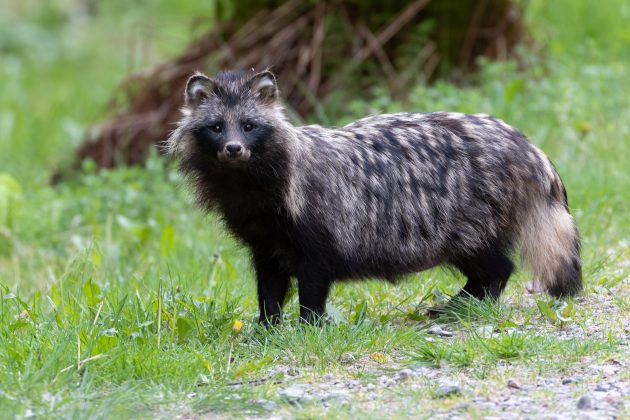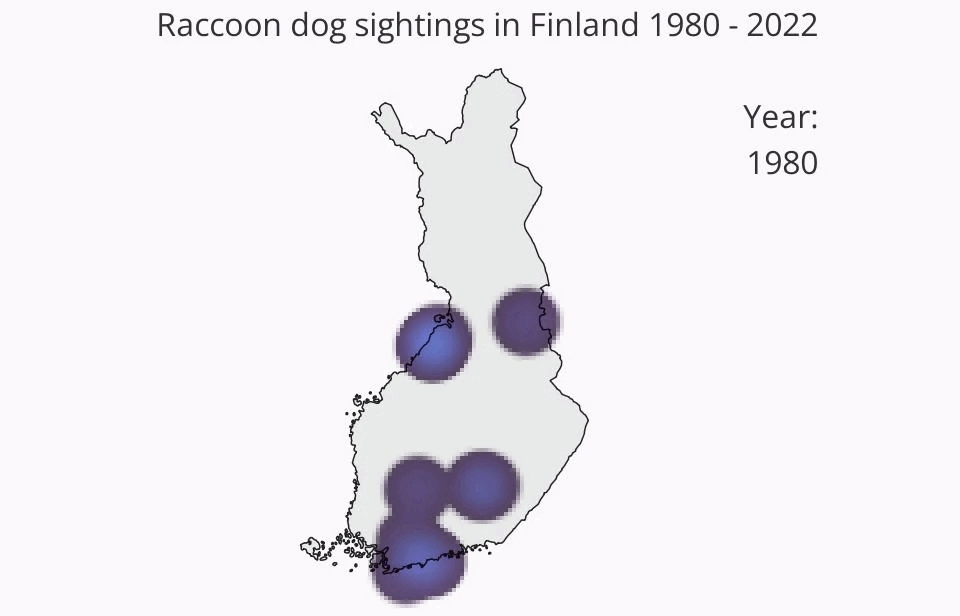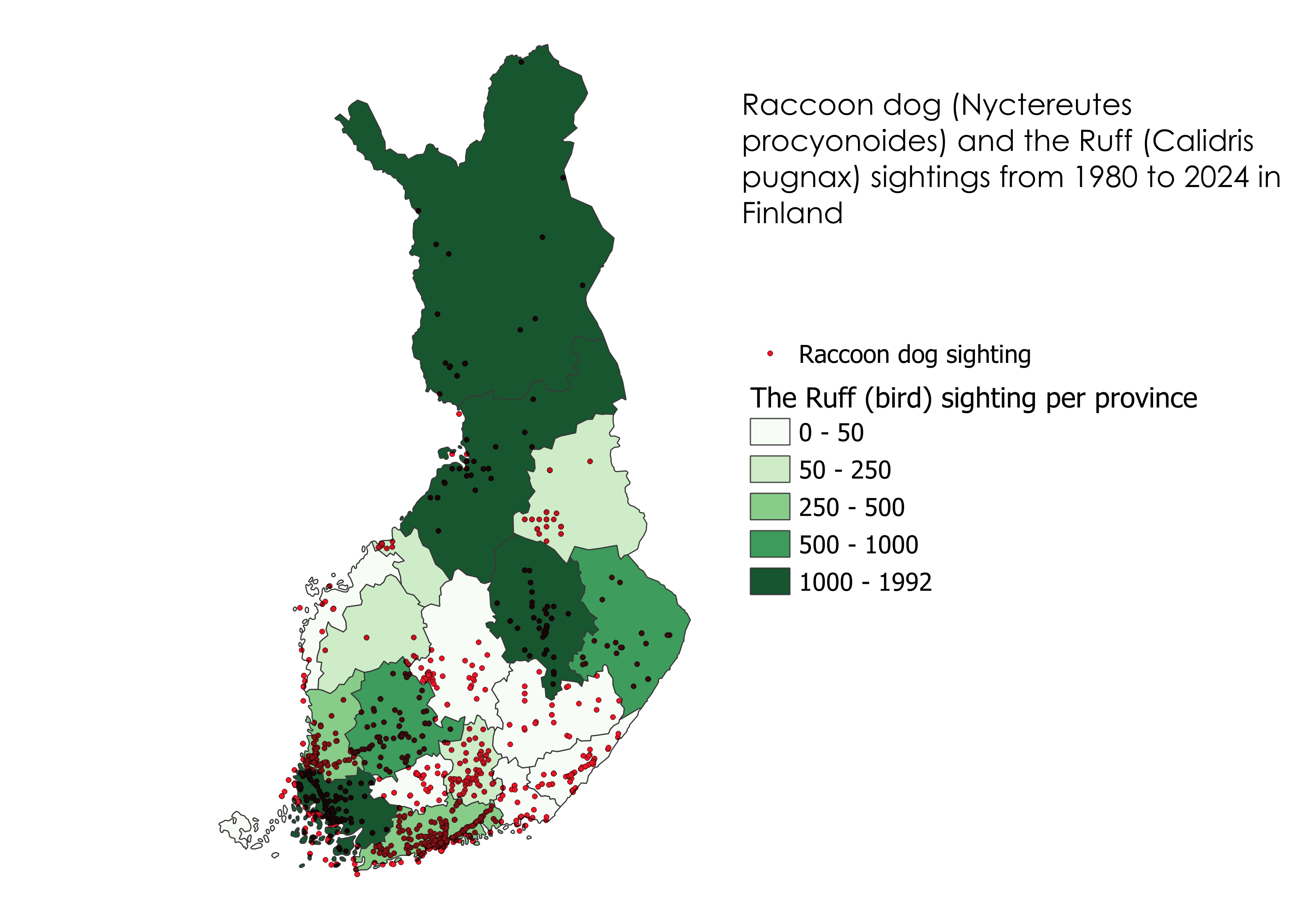The raccoon dog
The raccoon dog has been designated as a harmful invasive species throughout the entire EU (Vieraspeto, 2024). The raccoon dog is a carnivorous animal (Carnivora) belonging to the dog family (Canidae), originally from Asia. The raccoon dog is omnivorous, with a varied diet that includes small mammals, frogs, bird eggs, various plant foods, and garbage. Raccoon dogs thrive in various habitats and are mostly active at night (Vieraspeto, 2024).

The raccoon dog originally comes from Southeast Asia. It was initially brought to Finland to be farmed for its fur. Still, the current wild population originates from individuals that spread into Finland from the area of the former Soviet Union across the eastern border of Finland (Vieraspeto, 2024). Currently, the raccoon dog is common throughout the country, except in the northernmost part of Lapland.

The video illustrates the spread of raccoon dog sightings in Finland from 1980 to 2022. The animation shows the geographic expansion of the raccoon dog population over the years. The map video provides a visual representation of how the raccoon dog has established itself throughout Finland, with concentrations in southern Finland. The notable thing is that when coming nearer the current year we see a increase of sightings also in Lapland. Even though raccoon dog isn’t common in Lapland it has been expanding it’s habitat to there as well.
In the early years (1980s), sightings are localized, with few clusters indicating limited spread. As the video progresses into the 1990s and 2000s, the raccoon dog sightings increase and spread to larger areas. One thing to take into consideration is the way the data is produced. As the data is based on sightings made by people they are more clustered around big cities as there are more people making those sightings. The amount of sightings recorded also varies quite a lot trough the years (Plot 1) which can mean changes in estimated raccoon dog population is actually just variation how much people have officially recorded sightings to GBIF.

Ecological Impact
The raccoon dog is an opportunist that takes advantage of whatever food is available at any given time. In the autumn, it often eats berries, insects, and carrion (Vieraspeto, 2024). During the breeding season in spring and summer, the raccoon dog poses a significant threat to ground-nesting birds, as there is not much alternative food available in nature (Vieraspeto, 2024). At this time, bird eggs and chicks serve as its main food sources.
The raccoon dog particularly threatens endangered species in bird wetlands and coastal meadows. In open landscapes, ground-nesting species are easy prey for it (Vieraspeto, 2024). This is especially pronounced in areas with dense raccoon dog populations, where bird nests on the ground have little chance of success. A pair of raccoon dogs can destroy dozens of nests in a coastal meadow without the nests significantly contributing to the raccoon dogs’ overall diet (Vieraspeto, 2024). A nest of eggs is practically just a snack for the raccoon dog.

The map (Map 1) represents an example as how raccoon dog can pose a threat to a endangered bird species as their habitats overlap significantly. The ruff (Calidris pugnax) is categorized as critically endangered in Finland and nests on the ground which makes it a good example as possible victim to raccoon dogs nest destruction. From the map it is noticeable that particularly in the southern regions a significant overlap of these two species, suggests a potential for ecological impact.

As the plot shows (Plot 2) 75% of raccoon dog sightings occur within a 10-kilometer buffer zone around nationally designated protected areas. This suggests that raccoon dogs are frequently found near or potentially within protected areas, posing a potential threat to the ecosystems and species that these areas aim to conserve, like for example the Ruff.
Conclusion
In conclusion, the raccoon dog, has established itself as a adaptive invasive species across the country. Originating from Southeast Asia, its wild population spread from neighboring regions into Finland, showing a notable expansion visible in the sightings data. This expansion, showed in both video and plotted formats, highlights its growing presence, particularly in southern Finland and, more recently, encroaching into Lapland.
Ecologically, the raccoon dog’s omnivorous diet and opportunistic eating habits pose significant challenges, especially during critical periods like breeding seasons when it preys upon ground-nesting birds. This predatory behavior threatens vulnerable species for example the ruff whose nesting sites overlap extensively with the raccoon dog’s habitat. The geographic overlap of these species underscores the ecological impact, with implications for biodiversity conservation efforts in protected areas where raccoon dog sightings are notably concentrated.
As efforts continue to control and manage this invasive species, understanding its spread dynamics and ecological interactions remains very important. Effective mitigation strategies will be essential in mitigating further impacts on native wildlife and ecosystems in Finland.
Reference
Vieraspeto. (2024). Supikoira: elintavat, tunnistaminen ja haitallisuus. Vieraspeto. Retrieved June 16, 2024, from https://vieraspeto.fi/vieraspedot/supikoira-elintavat-tunnistaminen-ja-haitallisuus/?doing_wp_cron=1718346454.28805303573608398437
